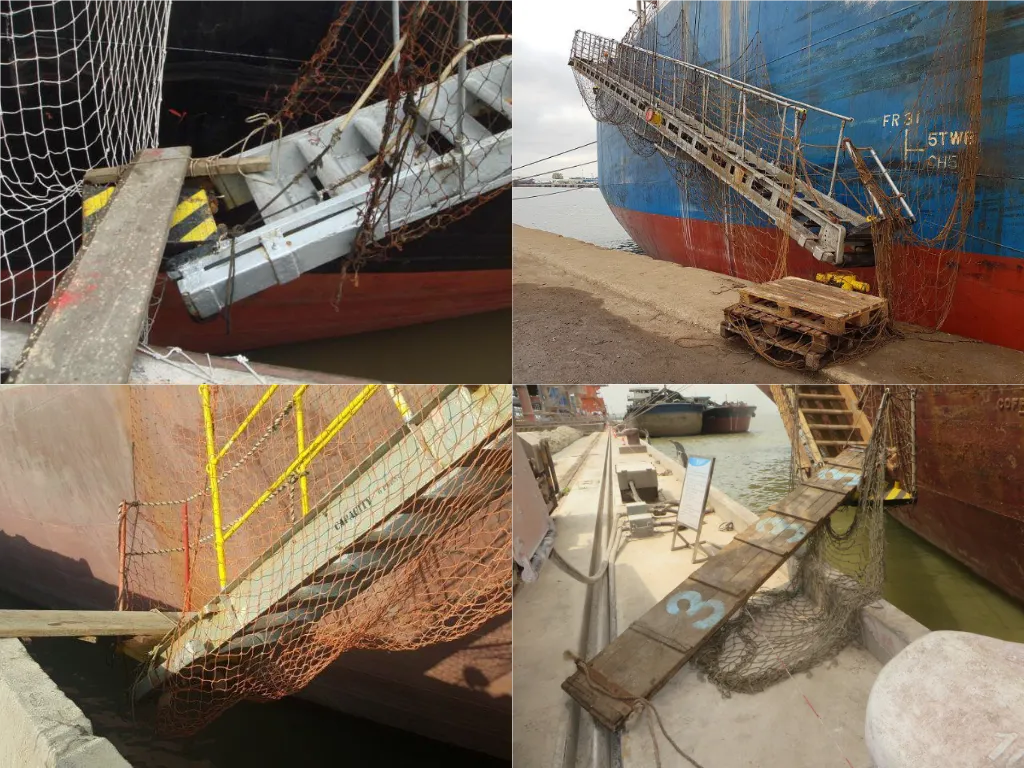Fixed accommodation ladders – usually attached to a turntable at the ship’s side – are designed to be landed on the wharf.
The photographs above show some of the improper means of access offered to RightShip Inspectors for boarding.
Best practise preventative actions
Things are, however, not always straightforward. Wharf aprons can have obstructions, capping or bollards, and can be restrictive in the amount of flat surface available for landing – i.e. clearance from crane bogies. These physical obstructions can sometimes be avoided by good forward planning and discussions with the agent, terminal and pilot – for example, it may be possible that the vessel can be positioned in such a way that the accommodation ladder can be safely landed.
Some terminals have restrictions on landing the ladder, and this needs to be challenged when there is no obvious reason for the approach taken.
A landed accommodation ladder needs careful ongoing monitoring to ensure that it remains free of obstruction and continues to be safely deployed within the design angles of operation, as the freeboard and trim change.
In analysis covering a one-month period, RightShip Inspectors found that less than 30% of the accommodation ladders that should have been landed on the wharf had, in fact, been landed. This highlights
- the need for vigilance
- the potential for damage to the ladder where this is lacking, and
- the availability of personnel to make adjustments when required.
It has become common place to use a short brow gangway attached to the bottom platform of an accommodation ladder, which is then left resting alongside the ship side. However, it is important to appreciate that this presents an elevated risk when compared to a landed ladder.
Whether you use a landed accommodation ladder or otherwise, all means of access should be subject to an ongoing, realistic and robust hazard ID and risk assessment process.
On occasion, RightShip Inspectors have seen cursory risk assessments where the consequence and likelihood of incidents have been grossly underestimated. Where the accommodation ladder is not landed, we would recommend that the consequence input to the assessment should be considered to be nothing less than a fatal injury.
Where the accommodation ladder is suspended, the potential for failure or sudden movement of the ladder is considerably increased. The following short video clip, which appears to have been recorded by a shore crane camera, highlights the dangers of working with suspended accommodation ladders. Please note that we have no knowledge of the origin of the footage or the welfare of the worker involved.
When using a suspended ladder arrangement, we would strongly suggest considering the following:
- rise and fall of tide
- passing traffic / potential for vessel surging
- prevailing and predicted weather conditions
- time elapsed since the last load test and inspection of the wires, winch and hoisting arrangement
- clear access and lighting
- if an approved secondary means of support (other than the hoisting wires) is to be utilised
If a short brow gangway is used, we would strongly suggest considering the following:
- if the ladder is certified and tested, if supplied by the vessel
- whether the ladder’s certification and testing are known or unknown, if not supplied by the vessel
- if the SWL of the lower platform of the accommodation ladder is known or unknown
- how the short brow is to be attached to the accommodation ladder
- It is important that a properly rigged safety net is deployed along the full length of the arrangement. This prevents anyone falling from the means of access into the gap between the ship and the wharf.
As a final note, if the risk assessment and risk mitigating measures cannot reduce the residual risk to “As Low As Reasonably Possible”, then an alternative should be considered – such as boarding on the outboard side by launch.
If it is not a safe means of access, don’t use it.
Article written by:
Tony Honeyborne – Senior Vetting Superintendent, RightShip
